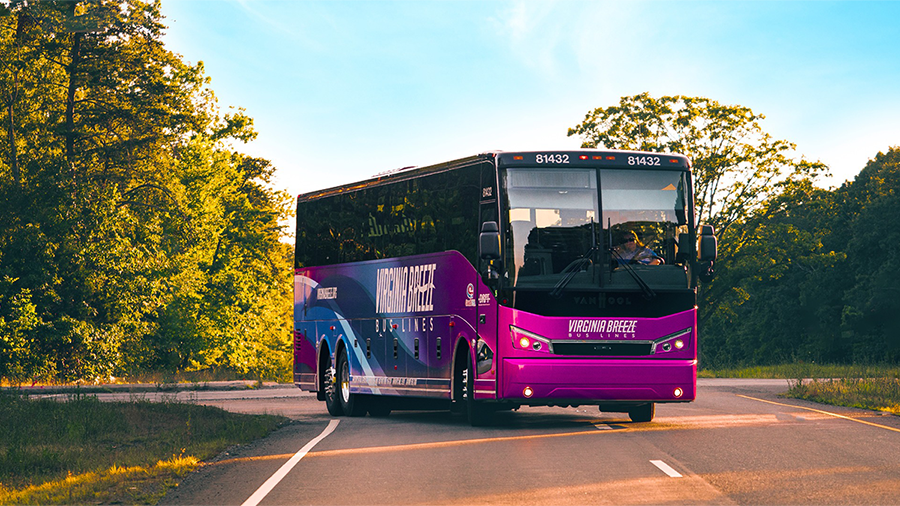For the first time, Virginia Breeze bus lines could offer east-to-west service across the commonwealth, from Harrisonburg to Virginia Beach, starting next summer.
An announcement about the new bus travel option is expected in May pending approval by the Commonwealth Transportation Board, which will pick one of two possible route plans and give an annual investment of at least $500,000 to fund the effort.
This story was reported and written by our media partner The Virginia Mercury
“To be able to get east-west as well as that diagonal north-south corridor would be a great benefit to all of our constituents,” said Laura Dent, chair of the Harrisonburg-Rockingham Metropolitan Planning Organization.
Established in 2017, the Virginia Breeze is an intercity bus service that connects underserved rural communities daily to other transportation modes, such as the national bus network. The Breeze, which has experienced an increase in ridership since the pandemic, offers four routes that connect cities in western and central Virginia to Washington, D.C.
The service is funded through the Federal Transit Administration’s Intercity Bus Program, ticket sales, and I-81 improvement funding from the Virginia Department of Transportation.
Last December, the Breeze’s monthly ridership reached 6,126, which was 214% higher than the department’s original estimates and 13% higher than in 2022. The Breeze also contributed to a reduction of 270 metric tons of CO2-equivalent emissions last December.
To meet Federal Transit Administration requirements, Virginia assessed the intercity services between Interstate 64 in the Tidewater area and the I-81 interchange in the Shenandoah Valley. Officials also identified the needs and opportunities for east-west service via a public survey.
According to a report by officials from the Virginia Department of Rail and Public Transportation, the survey’s respondents overwhelmingly wanted east-west service and two round trips per day.
Survey results also determined that Richmond, Charlottesville, Virginia Beach, Harrisonburg, Williamsburg, Norfolk, and Stauton were the top seven priority stops for riders. High-interest destinations include schools, military bases, and medical facilities.
“I think it’s a wonderful possibility,” Jennifer DeBruhl, executive director for DRPT, said of the possible Breeze expansion. “We’ve long seen this east-west corridor as a gap in our system and what we’ve seen from our stakeholder outreach, and the technical work in the study is that there’s a lot of demand in that corridor.”
The proposal
While the bus service expansion will run from Harrisonburg to Virginia Beach, the board will decide between two route plans that will each generate at least 16,000 riders a year and require an annual half-million dollar investment from the commonwealth.
The Alternative 1 route plan calls for stops at Richmond International Airport and in Newport News, Williamsburg and New Kent, while Alternative 2 includes stops in Suffolk, Petersburg and Richmond’s Staples Mills area, a transportation hub which is also home to Amtrak’s most-used train station in the Southeast.
Alternative 1 is estimated to generate 18,250 riders per year and will need $506,010 in annual operating costs. Alternative 2, the longer route of both options, is estimated to generate 16,060 riders yearly and require $572,701 in state funds each year.
The proposed east-west route only connects to existing connection points in Richmond, making the plan ineligible for matching federal funds because it does not connect to cities required by the Federal Transit Administration’s program, such as New York, Philadelphia, and Washington, D.C.
The Commonwealth Transportation Board will likely announce its preferred route in May before the route’s slated launch next summer.
Meeting the demand
The demand for local and statewide bus services has increased since regional services like Greyhound have reduced their transport offerings and because more Virginians are returning to in-person learning and working since the pandemic. Other travelers are also seeking different modes of transportation to cut back on driving and reduce their carbon footprint.
Robert Crum, executive director of the Hampton Roads Transportation Planning Organization, did not directly answer which Breeze route the organization prefers but said his group and the Hampton Roads Planning District Commission are excited about the proposed expansion coming to their area.
Similarly to the benefits of expanded passenger rail connections, Crum said, “providing additional opportunities for residents and visitors to move seamlessly to and within Hampton Roads is something to be celebrated.”
Beyond boosting the area’s tourism and economic opportunities, Crum continued, the expanded Breeze line will “serve as an alternative to automobiles on our interstate transportation network.”

